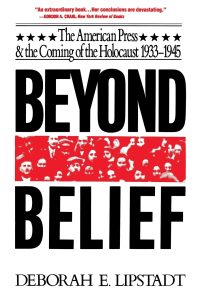From the Archives: Beyond Belief
I’ve reached a point in the revision process where I’m going back to books I read early in the research process. Because while some people may write and re-write in an absolute straight line, I do not. I move back and forth, and sometimes I zigzag. I’m definitely in a zigzag phase as I draw to the end.
One of the books I’ve gone back to is Deborah Lipstadt’s Beyond Belief, which offers an important look at “fake news” and other currently relevant topics in the context of the Holocaust. I first shared it with you in 2020. I think it’s worth another look.
I am currently taking notes on a pile of secondary source that I read over the last few months. I stuffed them full of sticky tabs as I went and moved on. On the surface, it’s not the most efficient way to do research, and I don’t always have the time to do it. But when time allows, I find it tremendously valuable. Coming back to the material a second time with a fresh eye and more information allows me to make connections that I didn’t make the first time. Re-reading is like re-writing as far as I’m concerned. It’s where the magic happens.
I just finished my second pass on Deborah Lipstadt’s Beyond Belief: the American Press and the Coming of the Holocaust, 1933-1945. The first time through it didn’t even occur to me share it with you.* And yet, and yet: it is important, not only for understanding how Americans could have remained ignorant of the Holocaust at the time, but also as a starting point for the mindset that makes today’s charges and counter-charges of “fake news” possible.
The work had its roots in the classroom. After Lipstadt told her class that detailed information about the Nazi attempt to exterminate European Jews had been available to the Allies very early in the war, one of her students angrily responded “But what did the public—not just the people in high places—know? How much of this information reached them? Could my parents, who read the paper every day, have known?”
Lipstadt argued that a great deal of information was available. American reporters who were stationed in Germany until the United States entered the war had reported on the Nazis in detail, including information about Germany’s persecution of the Jews.
The student wasn’t convinced. “No,” he said. “I can’t believe people could have read about all this in their daily papers.”
Beyond Belief began as Lipstadt’s attempt to prove that she was right. Her final conclusion, which she offers to the student in her acknowledgements: “I was right, but so were you.”
The book consists of a detailed look at who reported what and when, what their editors did with it after they reported it,** and how readers responded. Some of the most powerful portions of the book, and the ones that I think are most important for us today, discuss what Lipstadt describes as “the barriers to belief.” The most critical of these was a legacy from World War I. Stories of German atrocities were reported in the first World War that later proved to be false. The result was an attitude of what journalist and historian William Shirer called “supercynicism and superskepticism” about reports of atrocities. As a group, Americans said “Fool me once, shame on you. Fool me twice, shame on me.” unfortunately, this time the stories were true.
Be warned, Beyond Belief is not an easy read. Lipstadt’s style is clear, but her work is dense with data. Nonetheless, I found it a worthwhile read for reasons well beyond my current research.
*I don’t normally discuss purely academic works of history here in the Margins. They have a different purpose and a different audience and occasionally just plain hard to read.
**Important stories often got buried deep in newspapers. Editors (and sometimes reporters) added seeds of doubt to the reported stories. And some papers didn’t run the stories at all.






Reading through your presentation I find several names and dates come to my Octogenarian mind. A young Virginia Hanlon in 1897, asked her New York news paper editor father, Philip F. Hanlon, if there was a Santa Clause. The answer printed in an editorial (actually written by a Francis Phacellus Church )was a flat out “Yes” saying, “If you see it in the Sun, it is so”. Wikipedia excerpted!…1963 we have J. Kennedy and Dallas Texas and whoever killed him! The next date and names with many before and in between are 1974 – R. Nixon – H.
Watergate and in 2003 – Iraq – G. W. Bush – W. Chanie – C. Powell. For 2016 there was H. Clinton – D. Trump. When 2020 came, D. Trump – J. Biden- political quagmire. In the media the Fake News with division and derision ran a muck. The question of Truth or Dare further shredding the mind sets of the indoctrinated American public on either side was cemented. We no longer are that child like, naive society but the hardened, cynical, hate bearing at times, twenty first century ignoramus some have chosen to become.